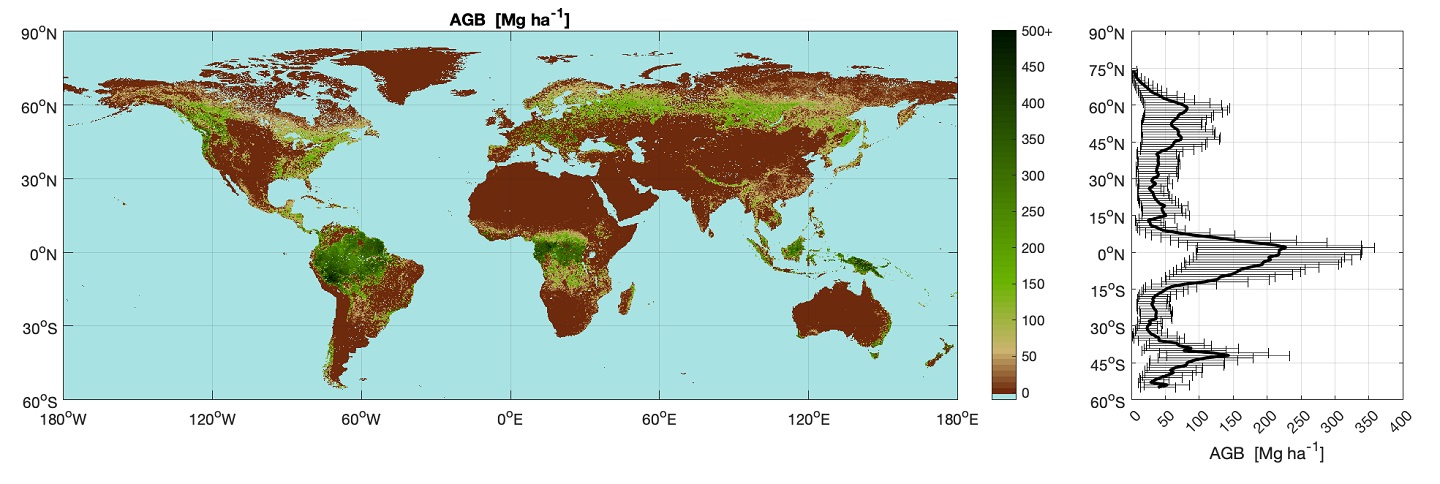Maps reveal where forests are changing around the world

Satellite map produced by the project
10 January 2022
Maps revealing areas of the world’s forests which have substantively changed over the past decade have been published through a European Space Agency (ESA) project that is managed and coordinated by Aberystwyth University.
The space agency’s Climate Change Initiative Biomass project, which has brought together researchers from across Europe, has developed a way of estimating the weight of above ground components of forests.
The research uses satellite data to produce high resolution maps showing which of the planet’s forests are being lost or expanding.
They illustrate substantive losses of forests through tropical deforestation and timber harvesting in the Amazon and central Africa, the impact of the recent bush fires in Australia, the impacts of larch disease in the UK and forest growth in some areas of Siberia.
Forests are one of the key natural methods of carbon capture by storing it in their trunks, branches and roots.
When trees are cleared through the likes of deforestation or are consumed by wildfires, they can release this carbon dioxide back into the atmosphere. This contributes to greenhouse gas concentrations, increasing global warming.
The new research allows the stocks of carbon to be estimated at a global level as well as their potential contributions to climate change.
As part of this project, Aberystwyth University and ESA have also collaborated with NASA and the Japan Aerospace Exploration Agency (JAXA) to develop a platform which can be used to access and improve global and regional means of tracking the loss of forest biomass.
Professor Richard Lucas from the Earth Observation Group at Aberystwyth University said:
“Over recent decades, we have seen substantial losses of forest cover globally leading to the associated release of carbon that is adversely affecting our climate. We have also been watching the progressive loss of the world’s biodiversity. These new maps can tell us where biomass is distributed globally and how it is changing. We need to use this information now to prevent further losses of forest integrity and proactively ensure that they are actively sinking carbon into the future.
“Forests are really only restoring the losses caused by land use change over recent decades and centuries and are playing a lesser role in compensating for overall emissions. Achieving net zero emissions from other sources as soon as possible is therefore essential if we are to address our changing climate.”
Professor Lucas added:
“A further purpose of our work with the space agencies is to provide biomass density maps that can be used in forest carbon estimation and reporting, and forest and land use management for climate mitigation purposes.
"Collectively, Aberystwyth University is making a substantive contribution to global efforts to address the climate and also biodiversity emergencies. We are ensuring these data become available to all interested and relevant stakeholders, including the public, to inform and drive proactive responses.”
Aberystwyth University has also worked with the Committee on Earth Observation Satellites to ensure public release of data relevant to the Paris Agreement. Those include global mangrove maps covering a number of years.
The team’s work was also recently showcased at COP26, where a global pledge was made to end deforestation by 2030.
Heather Kay from Aberystwyth University, who is coordinating the European Space Agency’s Climate Change Initiative Biomass project, commented:
“It was heartening to hear ministers and others at COP26 highlight the importance of the Earth Observation work we do here in Aberystwyth. There was wide recognition of the mantra that you can only manage what you can measure, and our maps of global above-ground forest biomass provide this sort of information. Given the new pledge made at COP26 to halt deforestation by 2030, our datasets can provide key information on whether these targets are being met.”
The researchers’ data can be viewed at the interactive Living Wales Exhibition at the Centre for Alternative Technology in Machynlleth, as well as on the European Space Agency Climate Change Initiative website.



